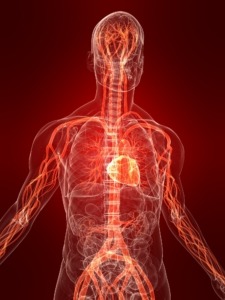Alpha-Linolenic Acid or α-linolenic acid (abbreviated to ALA) (18:3) is an unsaturated omega-3 fatty acid composed by 18 carbons and three cis double bonds. It must be acquired through diet because it is an essential fatty acid and it is an isomer of Gamma-linolenic acid (abbreviated to GLA). It is found mostly in seed oil – 20-35% – and even though it is also present in the soft parts of the berries, the proportion is lower. ALA and GLA have an important role in the human organism. They are a physiological component of cell membranes and mitochondria membranes and they play a role in the mechanism of cell transportation and the transmission of neuronal signals.
Cardiovascular disorders
The powerful cardio protective activity of ALA has been researched in many studies. ALA contributes to the maintenance of normal blood cholesterol levels. This effect is due to the ability of ALA to form precursors such as eicosapentaenoic acid (EPA) and docosahexaenoic acid (DHA) in the human body. However, ALA may have an impact upon health independently to its precursor role. Its cardio protective effects may be due to various mechanisms, such as the reduction of plaque calcification and the number of lipids, the maintenance of endothelial function, the reduction of blood pressure and the exhibition of antithrombotic, anti arrhythmic and anti-inflammatory effects.
Several scientists carried out a cohort study where there was an inverse and dose-dependent relation between dietary ALA (range, 0.17 to 3.48 g/d) and prevalent calcified atherosclerotic plaque in the coronary arteries (CAC). The presence of CAC is directly associated with the total burden of atherosclerotic plaques and its vulnerability. Consequently, the reduction of the presence of CAC decreases the risk of atherosclerosis, and viceversa.
Furthermore, a cross-over study with moderate hypercholesterolemic subjects was carried out to prove the influence of the diet in the inflammation process in cardiovascular disease. The three diets designed in this study were: American diet (control diet), a diet high in polyunsaturated fatty acids and ALA (ALA diet) and a diet high in polyunsaturated fatty acids and LA (LA diet). The subjects were assigned to a sequence of these 3 test diets: they consumed a diet for 6 weeks and before starting the other diet they had a break period of 3 weeks.
The results showed that ALA diet decreased C-reactive protein, a protein involved in the atherosclerotic process. Also, ALA diet decreased vascular cell adhesion molecule-1 (VCAM-1) and E-selectin compared to control diet. The 2 high-PUFA diets decreased serum total cholesterol, LDL cholesterol and TAG. In addition, ALA diet decreased HDL cholesterol and apolipoprotein and increased EPA levels in serum. The research concluded that a diet rich in ALA plays a role in reducing multiple cardiovascular disease risk factors such as decreasing pro inflammatory cytokines, changes in VCAM-1, lowering cholesterol levels or increasing EPA levels in serum. The anti arrhythmic mechanism of LA is postulated to be related to modulation of sodium and calcium channels of the cardio myocytes. Another cardio protective effect mentioned is the ability of ALA to reduce blood pressure.
Another study evaluated the antihypertensive activity of ALA in subjects with high-normal blood pressure and mild hypertension. The subjects were divided in two groups: a group which consumed 14 g of common blended oil and a group that intake ALA-enriched oil. The results revealed a significant decrease of systolic and diastolic blood pressure in the ALA-enriched group compared to the control group. The study concluded that ALA had an antihypertensive effect on blood pressure with no adverse effect during the study.
Dry eye
ALA is also related to several skin and mucous disorders. The actual treatments for the dry eye are not as efficient as they can be. For instance, artificial tears relieve symptoms without treating the causatives factors. Although anti-inflammatory drugs could produce side effects, they are still used to alleviate dry eye symptoms. In front of this situation, researchers are trying to investigate the potential effects of omega-3 fatty acids alone or with combination with omega-6 fatty acids in the treatment of dry eye. A randomized double-blind, parallel, placebo-controlled trial recruited a total of 100 volunteers to prove the beneficial effect of omega-3 in the treatment of dry eye. Two groups were formed and during 3 months (during the cold season) participants consumed 2 g of sea buckthorn oil or placebo. According to the results, sea buckthorn oil attenuated the increase in tear film osmolarity and it may influence in the maximum intensity of burning and redness symptoms of dry eye.
Bone health
The potential effect of ALA regarding the protection of bone is being evaluated. A study assessed the relation of bone mineral density biomarker (N-telopeptides) and different diets. The results showed a significant decreased of N-telopeptids in the case of rich-ALA diet and rich-LA diet compared to the control diet. The study concluded that ALA and LA may play an important role in bone turnover and maintenance of bone formation. Although these findings are encouraging, more robust data is needed. García and colleagues also carried out a study among 1865 females to investigate the role of the diet in bone heath. Bone mineral density, Ward’s triangle, femoral trochanter, hip and lumbar were measured by X ray. The dietary intakes of total energy, calcium, vitamin D, ALA, EPA, DHA, LA and arachidonic acid were assessed by a food questionnaire. The authors found positive correlations between ALA, EPA and DHA with bone mineral density.

Leave A Comment